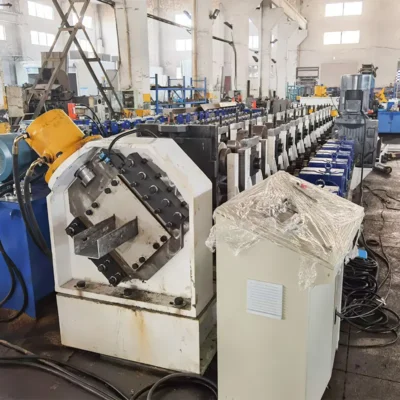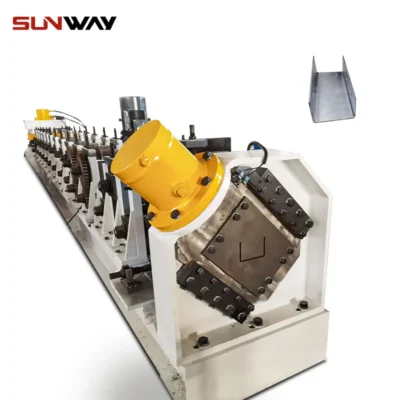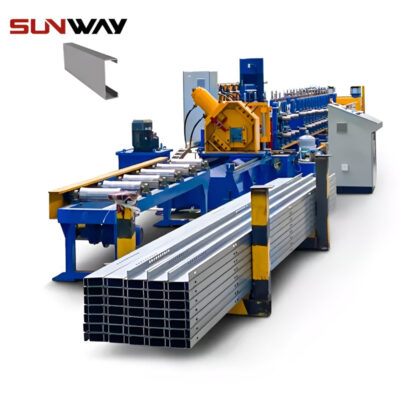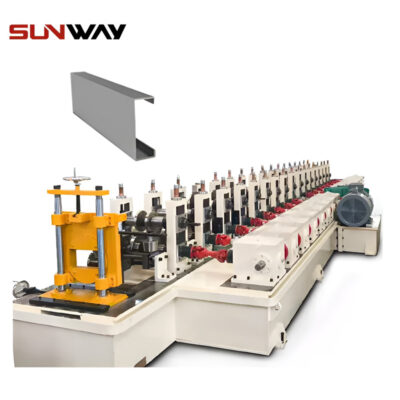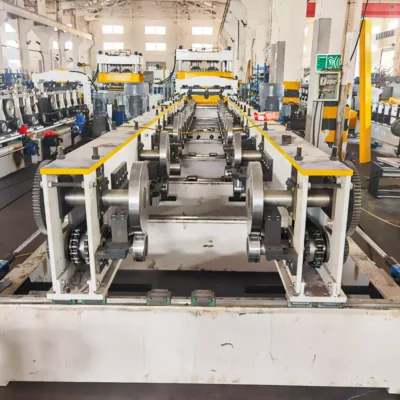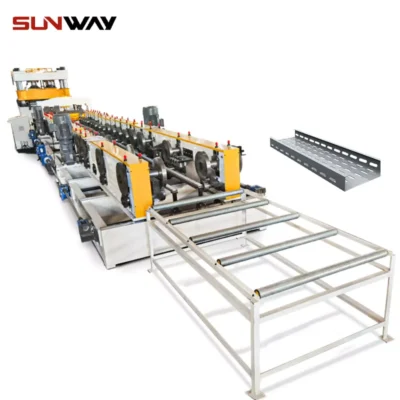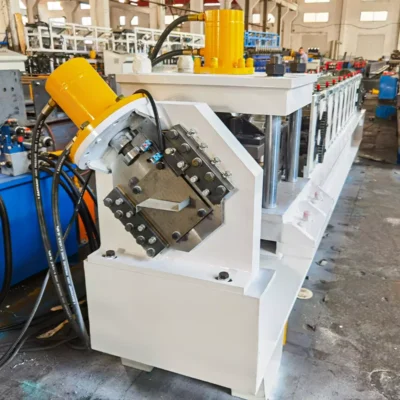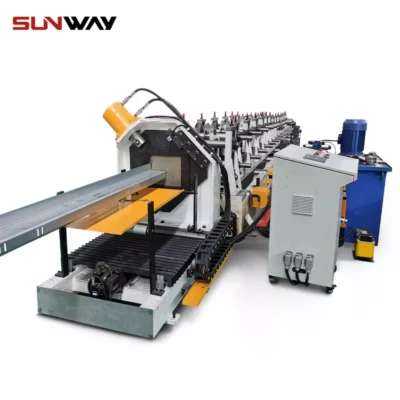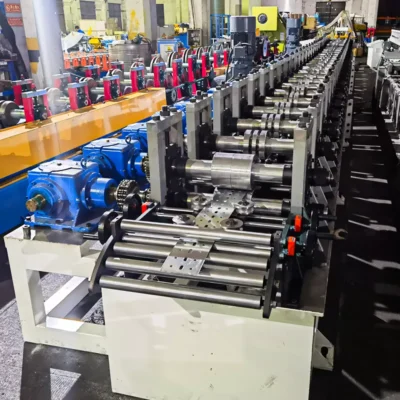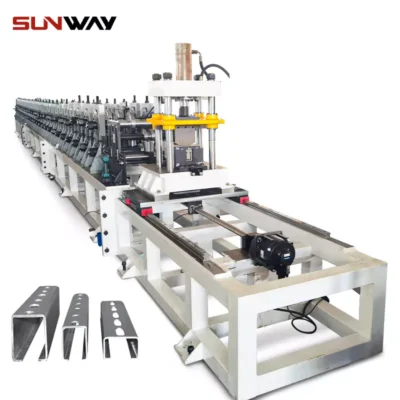As humanity embarks on a bold journey into the final frontier, the need for precision-engineered satellite components has never been greater. From commercial communications satellites to advanced spacecraft for scientific exploration, the demand for high-quality, lightweight, and durable components is skyrocketing. At the heart of this innovation are Satellite Component Roll Forming Machines—specialized industrial equipment designed to manufacture intricate metal profiles and panels used in satellite construction.
In this comprehensive guide, we’ll explore Satellite Component Roll Forming Machines, their applications, technological advancements, benefits, pricing, and why Wuxi Sunway Machinery is a trusted name in this pioneering field. Whether you’re in aerospace manufacturing or simply fascinated by the cutting-edge technology that propels us into space, this article will provide an in-depth look into these transformative machines.
What is a Satellite Component Roll Forming Machine?
ক Satellite Component Roll Forming Machine is a precision-engineered piece of equipment designed to produce metal profiles, panels, and frames used in satellite construction. These components must meet stringent specifications for lightweighting, strength, and resistance to extreme temperature fluctuations.
The roll-forming process shapes metal coils into complex profiles through a series of rollers. Unlike traditional manufacturing methods, roll forming offers unmatched precision, consistency, and efficiency—key factors in the production of satellite components that must endure the harsh conditions of space.
With the growing focus on space exploration, satellite communications, and Earth observation, Satellite Component Roll Forming Machines are enabling manufacturers to meet the increasing demand for high-quality satellite parts.
Applications of Satellite Component Roll Forming Machines
The components produced by roll-forming machines are critical to the construction and performance of satellites, ensuring they can withstand the challenges of space travel. Here are some of their primary applications:
1. Structural Frames
- Use Case: Frames provide the skeleton for satellites, supporting all onboard systems and payloads.
- Why It Matters: These components must be lightweight yet robust to ensure the satellite’s structural integrity.
2. Solar Panel Frames
- Use Case: Roll-formed frames are used to support satellite solar panels, which generate the power needed for operation.
- Why It Matters: Precision and consistency are essential to ensure the panels align correctly and deploy smoothly in space.
3. Antenna Supports
- Use Case: Frames and brackets for satellite antennas ensure accurate communication with ground stations.
- Why It Matters: High accuracy and stability are vital for maintaining signal transmission over vast distances.
4. Heat Shields
- Use Case: Panels produced by roll-forming machines are used in thermal protection systems to shield satellites from extreme heat.
- Why It Matters: Ensures the satellite’s internal systems remain operational in the harsh environment of space.
5. Payload Enclosures
- Use Case: Roll-formed panels protect sensitive satellite payloads, such as scientific instruments or communication modules.
- Why It Matters: Robust enclosures prevent damage during launch and in orbit.
6. Satellite Bus Components
- Use Case: The bus houses essential subsystems such as propulsion, power, and communication systems. Roll-formed components ensure a compact and efficient design.
- Why It Matters: Enables satellites to maximize payload capacity and operational efficiency.
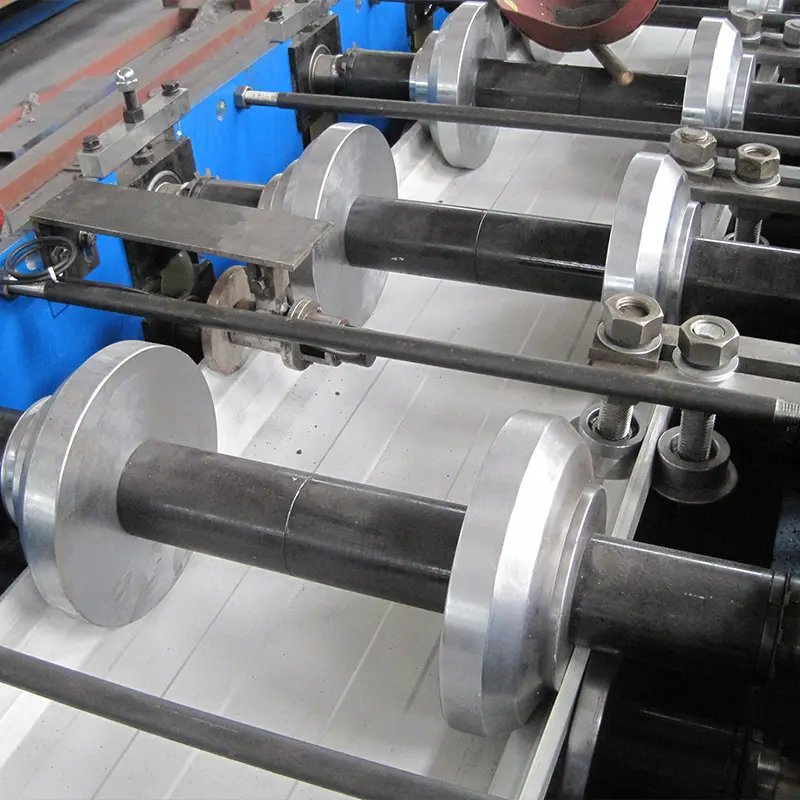
Key Features of Wuxi Sunway Satellite Component Roll Forming Machines
When it comes to manufacturing satellite components, Wuxi Sunway Machinery offers state-of-the-art roll-forming machines tailored to the unique requirements of the aerospace industry. Here’s what sets their machines apart:
1. Precision Engineering
- What It Does: Produces components with tight tolerances and smooth finishes, essential for aerospace applications.
- Why It’s Important: Ensures compatibility with other satellite systems and enhances overall performance.
2. Lightweight Material Compatibility
- Supported Materials:
- Aluminum alloys
- Titanium
- High-strength steel
- Composite materials
- Why It’s Crucial: Allows for the production of lightweight components critical for reducing satellite launch costs.
3. Multi-Profile Capabilities
- What It Offers: Produces a variety of profiles, from U-channels and Z-sections to complex custom designs.
- Why It’s Revolutionary: Supports the production of diverse satellite components, catering to various mission requirements.
4. Integrated Cutting and Punching Systems
- Features: Servo-driven cutting and punching systems ensure precision in creating holes, slots, and edges.
- Why It’s Important: Reduces the need for secondary operations, saving time and resources.
5. High-Speed Production
- Performance: Capable of producing up to 10 meters of profiles per minute, depending on the material and design.
- Why It Matters: Meets the high demands of satellite manufacturers while maintaining quality.
6. PLC-Controlled Automation
- Features:
- Fully programmable logic controllers (PLC) with an intuitive touchscreen interface.
- Stores multiple design parameters and production settings.
- Real-time monitoring and error detection.
- Why It’s Revolutionary: Simplifies operation and ensures consistent quality across production runs.
7. Compact and Modular Design
- What It Does: Offers a space-saving design that integrates seamlessly into existing production lines.
- Why It Matters: Optimizes factory floor space and allows for easy upgrades.
8. Enhanced Safety Features
- Highlights:
- Emergency stop buttons for immediate shutdown.
- Overload protection to prevent mechanical damage.
- Safety shields for moving parts to protect operators.
- Why It’s Critical: Ensures a safe working environment without compromising productivity.
Production Workflow of a Satellite Component Roll Forming Machine
The production process for satellite components is meticulously designed to ensure precision and efficiency. Below is an overview of the workflow:
1. Decoiling
- Lightweight metal coils are loaded onto the decoiler, which feeds the material into the machine.
2. Leveling
- A leveling system ensures the material is flat and free from warping before entering the roll-forming section.
3. Roll Forming
- The material passes through a series of rollers that gradually shape it into the required profile.
4. Punching and Cutting
- Integrated punching units create precise holes and slots, while cutting systems trim the profiles to the specified lengths.
5. Surface Treatment
- Some machines include options for surface treatments like anodizing or anti-corrosion coatings.
6. Stacking
- Finished components are automatically stacked for easy packaging and transportation.
Pricing of Satellite Component Roll Forming Machines
The cost of a Satellite Component Roll Forming Machine depends on its features, production capacity, and level of customization. Below is a general pricing guide for 2025:
| Machine Type | Capabilities | Price Range (USD) |
|---|---|---|
| Standard Machines | Basic satellite component production | $150,000–$250,000 |
| High-Precision Machines | Enhanced tolerances and surface finishes | $250,000–$400,000 |
| Fully Customizable Machines | Advanced features and multi-material capability | $400,000–$600,000 |
For tailored pricing and financing options, contact Wuxi Sunway Machinery.
Advantages of Using a Satellite Component Roll Forming Machine
Investing in a Satellite Component Roll Forming Machine offers numerous benefits for aerospace manufacturers:
1. Precision and Consistency
- Ensures components meet the stringent quality standards required for space missions.
2. Material Versatility
- Supports the use of lightweight and high-strength materials essential for aerospace applications.
3. Cost Efficiency
- Reduces material waste and labor costs, improving overall profitability.
4. Scalability
- High production capacity allows manufacturers to meet the growing demand for satellites.
5. Innovation
- Enables the production of complex profiles and designs, advancing satellite technology.
FAQs About Satellite Component Roll Forming Machines
| Question | Answer |
|---|---|
| What is the production speed? | Machines can produce up to 10 meters of profiles per minute, depending on the design. |
| Can the machine handle titanium? | Yes, it is compatible with lightweight and high-strength materials like titanium. |
| What is the material thickness range? | Compatible with thicknesses ranging from 0.4mm to 2.5mm. |
| Does Sunway offer customization? | Absolutely! Sunway specializes in tailoring machines to meet unique aerospace requirements. |
| Is operator training included? | Yes, comprehensive training is provided with every machine purchase. |
| What is the warranty period? | All Sunway machines come with a 12-month warranty, with extended options available. |
| How long does installation take? | Installation and commissioning typically take 5–10 days, depending on factory setup. |
Global Trends Driving the Demand for Satellite Component Roll Forming Machines
The space industry is witnessing unprecedented growth, fueled by advancements in technology, increasing commercial applications, and international collaboration. Here are the top trends influencing the adoption of Satellite Component Roll Forming Machines in 2025:
1. New Space Economy and Satellite Boom
- The Numbers: The global space economy is projected to exceed $1 trillion by 2040, with satellites accounting for a significant portion of this growth.
- Impact on Manufacturing: The demand for small satellites, mega-constellations, and geostationary satellites is driving the need for quick and precise component production.
- Why It Matters: Roll-forming machines enable manufacturers to produce components at scale, meeting the high volume requirements of the growing satellite market.
2. Small Satellite Revolution
- The Context: Small satellites (weighing less than 500 kg) are transforming industries like telecommunications, Earth observation, and IoT.
- Impact on Component Design: These satellites require lightweight, compact, and high-performance components.
- Why It’s Important: Roll-forming machines can produce ultra-lightweight and precise profiles, making them ideal for small satellite production.
3. Rise of Mega-Constellations
- The Trend: Companies like SpaceX, Amazon, and OneWeb are deploying thousands of satellites to create global broadband networks.
- Impact on Manufacturing: High-speed, scalable production is essential to meet the demand for mass deployment.
- Machine Relevance: Roll-forming machines offer the speed and consistency needed for such large-scale manufacturing.
4. Focus on Reusability
- What’s Happening: As part of cost-saving and sustainability efforts, satellite manufacturers are designing components for reusability.
- Impact on Manufacturing Processes: Components must meet higher durability standards while remaining lightweight.
- Why It’s Exciting: Roll-forming machines can produce high-strength profiles that meet reusability requirements.
5. Space Exploration and Deep-Space Missions
- The Push: Missions to the Moon, Mars, and beyond require satellites with advanced designs and robust components.
- Impact on Component Manufacturing: Components must withstand extreme conditions, including radiation, high temperatures, and microgravity.
- Why It Matters: Roll-forming machines can produce components with customized alloys and finishes suited for deep-space exploration.
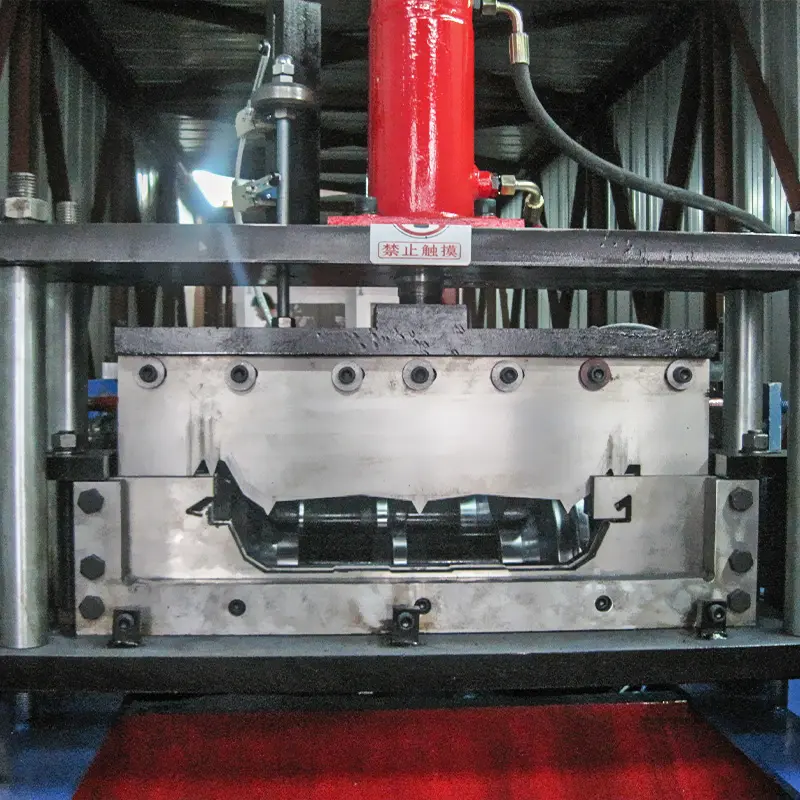
Technological Advancements in Satellite Component Roll Forming Machines
The cutting-edge technology driving Satellite Component Roll Forming Machines is enabling manufacturers to keep pace with the demands of the rapidly evolving space industry. Let’s explore the key advancements shaping the future:
1. AI-Driven Quality Control
- What It Does: Artificial intelligence monitors the production process, identifying defects in real-time and ensuring consistent quality.
- Benefits:
- Reduces waste by catching errors early.
- Ensures every component meets aerospace standards.
- Improves overall production efficiency.
2. Multi-Material Processing
- How It Works: Modern machines can seamlessly switch between different materials, such as aluminum, titanium, and composites, without sacrificing precision.
- Advantages:
- Expands the machine’s versatility.
- Supports hybrid material designs for advanced satellite systems.
- Reduces downtime during material changes.
3. Advanced Surface Finishing
- The Innovation: Integrated surface treatment systems apply coatings like anodizing or anti-corrosion layers during production.
- Why It’s Revolutionary:
- Enhances the durability of components exposed to extreme space conditions.
- Reduces the need for post-production treatments, saving time and resources.
4. Modular and Compact Designs
- What It Offers: Machines are designed to fit into compact factory spaces while allowing for future upgrades.
- Why It Matters: Optimizes production floor layouts and offers scalability as production volumes increase.
5. Real-Time Data Analytics
- How It Works: IoT-enabled sensors collect data on machine performance, material usage, and output quality.
- Benefits:
- Provides actionable insights to improve production efficiency.
- Predictive maintenance minimizes downtime.
- Enhances traceability, a critical requirement in aerospace manufacturing.
6. High-Speed Roll Forming
- Performance: Modern machines can reach production speeds of up to 10 meters per minute without compromising precision.
- Why It’s Important: Meets the high throughput demands of mega-constellation and small satellite production.
Environmental Benefits of Satellite Component Roll Forming Machines
As the aerospace industry embraces sustainability, Satellite Component Roll Forming Machines are playing a pivotal role in reducing the environmental impact of manufacturing. Here’s how:
1. Minimizing Material Waste
- How It Works: Roll-forming technology optimizes material usage, reducing scrap and waste.
- Impact: Lowers production costs while conserving raw materials.
2. Energy Efficiency
- The Innovation: Modern machines are equipped with energy-efficient motors and systems that consume less electricity.
- Why It Matters: Supports manufacturers in reducing their carbon footprint.
3. Localized Production
- What It Does: Enables manufacturers to produce components locally, reducing the environmental impact of transportation.
- Outcome: Contributes to regional sustainability goals while reducing logistics costs.
4. Recyclable Components
- The Advantage: Components produced from aluminum and titanium are fully recyclable.
- Why It’s Important: Encourages a circular economy in satellite manufacturing.
Comparison: Satellite Component Roll Forming Machines vs. Traditional Methods
Let’s compare Satellite Component Roll Forming Machines with conventional methods, such as stamping or manual fabrication, in terms of efficiency, precision, and scalability:
| Feature | রোল ফর্মিং মেশিন | Traditional Methods |
|---|---|---|
| Precision | High; ensures tight tolerances and uniformity | Moderate; prone to variability |
| Production Speed | High; up to 10 meters per minute | Slow; dependent on manual labor |
| Automation | Fully automated with IoT and AI integration | Mostly manual or semi-automated |
| Material Waste | Minimal; optimized processes reduce scrap | Higher; less efficient material usage |
| কাস্টমাইজেশন | Easily customizable for complex profiles | Limited flexibility; requires separate tooling |
| Cost Efficiency | Higher initial cost, lower operational costs | Lower initial cost, higher long-term costs |
| Scalability | Ideal for mass production | Limited scalability for high-volume demand |
Additional FAQs About Satellite Component Roll Forming Machines
| Question | Answer |
|---|---|
| Can the machine produce components for deep-space missions? | Yes, it can handle materials and designs suited for extreme conditions like radiation and microgravity. |
| What is the maximum material thickness? | The machine can process materials up to 2.5mm thick, depending on the design. |
| What industries outside aerospace can use this machine? | Industries like renewable energy, automotive, and defense can also utilize roll-forming machines for high-precision components. |
| Does Wuxi Sunway provide installation support? | Absolutely! Sunway offers on-site installation and commissioning services. |
| How customizable is the machine? | Highly customizable; Sunway can tailor the machine to meet specific production and design needs. |
| What is the typical lead time for delivery? | Delivery takes 3–6 months, depending on customization requirements. |
Why Choose Wuxi Sunway Machinery for Satellite Component Roll Forming Machines?
Here’s why Wuxi Sunway Machinery is the leader in roll-forming technology for aerospace applications:
- Proven Track Record: Decades of expertise in delivering high-precision roll-forming solutions.
- Global Reach: Trusted by aerospace manufacturers worldwide, including Europe, Asia, and the Americas.
- Customization Expertise: Machines designed to meet the unique demands of satellite and space exploration projects.
- Sustainability Commitment: Eco-friendly designs minimize waste and reduce energy consumption.
- Cutting-Edge Technology: Features like AI-driven quality control and IoT-enabled monitoring set Sunway apart.
- Comprehensive Support: From operator training to after-sales service, Sunway ensures seamless operations.
Conclusion: Shaping the Future of Space Manufacturing
দ্য Satellite Component Roll Forming Machine is a cornerstone of modern aerospace manufacturing, enabling the production of high-quality components for satellites destined to orbit Earth and explore deep space. As the demand for satellites continues to grow, investing in advanced roll-forming technology is essential for manufacturers aiming to lead in this competitive industry.
Ready to elevate your production capabilities? Contact Wuxi Sunway Machinery today to explore their innovative roll-forming solutions. Together, let’s push the boundaries of what’s possible—one satellite component at a time!

